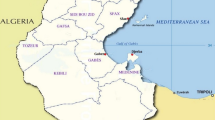Abstract
A hierarchical collection of isolates of the fungal pathogen Pleiochaeta setosa was made from field-grown Lupinus albus plants across southern NSW, Australia in 2004. This collection, along with some historical reference isolates, was analysed for genetic variation using random amplified polymorphic DNA and enterobacterial repetitive intergenic consensus primer PCR. Anchored inter-simple sequence repeat primers were tested but produced little or no amplification or no detectable polymorphism. The observed overall variation was not explained by the hierarchical structure of the population (individual seedling, host species, host cultivar, regional location, or year). There was significant genetic variation between isolates even at the finest sampling scale (within a single seedling). Some very distinct individual isolates were identified. The high level of scale-independent genetic diversity seen in P. setosa suggests that field-based screening for Pleiochaeta root rotresistant genotypes in a L. albus breeding program at a single location is likely to result in resistance which is effective at multiple and widely separated locations. This resistance would have an increased chance of being polygenically controlled and durable under commercial cultivation conditions.
Similar content being viewed by others
References
Alfonso C, Raposo R, Melgarejo P (2000) Genetic diversity in Botrytis cinerea populations on vegetable crops in greenhouses in south-eastern Spain. Plant Pathology 49, 243–251. doi: 10.1046/j.1365-3059.2000.00452.x
Ash GJ, Raman R, Crump NS (2003) An investigation of genetic variation in Carthamus lanatus in New South Wales, Australia, using intersimple sequence repeats (ISSR) analysis. Weed Research 43, 208–213. doi: 10.1046/j.1365-3180.2003.00335.x
Bagley MJ, Anderson SL, May B (2001) Choice of methodology for assessing genetic impacts of environmental stressors: polymorphism and reproducibility of RAPD and AFLP fingerprints. Ecotoxicology (London, England) 10, 239–244. doi: 10.1023/A:1016625612603
Barrins JM, Purwantara A, Ades PK, Salisbury PA, Howlett BJ (2002) Genetic diversity of isolates of Leptosphaeria maculans from a canola (Brassica napus) paddock in Australia. Australasian Plant Pathology 31, 129–135. doi: 10.1071/AP02001
Burgess TI, Wingfield MJ, Wingfield BD (2004) Global distribution of Diplodia pinea genotypes revealed using simple sequence repeat (SSR) markers. Australasian Plant Pathology 33, 513–519. doi: 10.1071/AP04067
Clewley JP (1998a)Auser’s guide to producing and interpreting tree diagrams in taxonomy and phylogenetics. Part 1. Introduction and naming of parts. Communicable Disease and Public Health 1, 64–70.
Clewley JP (1998b) Auser’s guide to producing and interpreting tree diagrams in taxonomy and phylogenetics. Part 3. Using restriction fragment length polymorphism patterns of bacterial genomes to draw trees. Communicable Disease and Public Health 1, 208–210.
Hayden HL, Cozijnsen AJ, Howlett BJ (2007) Microsatellite and minisatellite analysis of Leptosphaeria maculans in Australia reveals regional genetic differentiation. Phytopathology 97, 879–887. doi: 10.1094/PHYTO-97-7-0879
Hill GD (1998) Diseases of lupins. In ‘The pathology of food and pasture legumes’. (Eds DJ Allen, JM Lenne) pp. 559–589. (CAB International: Wallingford, UK)
Hsiang T, Mahuku GS (1999) Genetic variation within and between southern Ontario populations of Sclerotinia homoeocarpa. Plant Pathology 48, 83–94. doi: 10.1046/j.1365-3059.1999.00306.x
Jones CJ, Edwards KJ, Castaglioni S, Winfield MO, Sala F, van der Wiel C, Bredemeijer G, Vosman B, Matthes M, Daly A, Brettschneider R, Bettini P, Buiatti M, Maestri E, Malcevschi A, Marmiroli N, Aert R, Volckaert G, Rueda J, Linacero R, Vazquez A, Karp A (1997) Reproducibility testing of RAPD, AFLP and SSR markers in plants by a network of European laboratories. Molecular Breeding 3, 381–390. doi: 10.1023/A:1009612517139
Luckett DJ, Cowley RB, Richards MF, Roberts DM (2008) Improved methodology for screening for resistance to Pleiochaeta setosa root rot in Lupinus albus. In ‘12th international lupin conference, Fremantle, Western Australia’. (Eds JA Palta, J Berger) (International Lupin Association: Lincoln University, Canterbury, New Zealand)
Luckett DJ, Cowley RB, Richards MF, RobertsDM(2009) Breeding Lupinus albus for resistance to the root pathogen Pleiochaeta setosa. European Journal of Plant Pathology, in press. doi: 10.1007/s10658-009-9465-8
Ma ZH, Michailides TJ (2002) Characterization of Botryosphaeria dothidea isolates collected from pistachio and other plant hosts in California. Phytopathology 92, 519–526. doi: 10.1094/PHYTO.2002.92.5.519
Perrier X, Jacquemoud-Collet JP (2006) DARwin software. Available at http://www.darwin.cirad.fr/darwin [Verified 2 June 2009]
Purwantara A, Barrins JM, Cozijnsen AJ, Ades PK, Howlett BJ (2000) Genetic diversity of isolates of the Leptosphaeria maculans species complex from Australia, Europe and North America using amplified fragment length polymorphism analysis. Mycological Research 104, 772–781. doi: 10.1017/S095375629900235X
Raeder U, Broda P (1985) Rapid preparation of DNA from filamentous fungi. Letters in Applied Microbiology 1, 17–20. doi: 10.1111/j.1472-765X.1985.tb01479.x
Skroch P, Nienhuis J (1995) Impact of scoring error and reproducibilityRAPD data on RAPD-based estimates of genetic distance. Theoretical and Applied Genetics 91, 1086–1091. doi: 10.1007/BF00223923
Sweetingham M, Yang H (1998) ‘New sources of resistance to Pleiochaeta and Eradu patch disease in Lupinus spp.’(CLIMA- Centre for Legumes in Mediterranean Agriculture: Perth)
Tymon AM, Pell JK (2005) ISSR, ERIC and RAPD techniques to detect genetic diversity in the aphid pathogen andora neoaphidis. Mycological Research 109, 285–293. doi: 10.1017/S0953756204001807
Versalovic J, Koeuth T, Lupski JR (1991) Distribution or repetitive DNA sequences in eubacteria and application to fingerprinting of bacterial genomes. Nucleic Acids Research 19, 6823–6831. doi: 10.1093/nar/ 19.24.6823
Wunderlich N, Ash GJ, Harper JDI, Cowley RB, Luckett DJ (2008) Penetration and symptom development of Pleiochaeta root rot in susceptible and resistant Lupinus albus cultivars. Australasian Plant Pathology 37, 387–391. doi: 10.1071/AP08014
Yang HA, Sweetingham MW (2002) Variation in morphology and pathogenicity of Pleiochaeta setosa isolates from Lupinus spp. and other legumes. Australasian Plant Pathology 31, 273–280. doi: 10.1071/ AP02023
Author information
Authors and Affiliations
Corresponding author
Rights and permissions
About this article
Cite this article
Gan, M.J.T., Ash, G.J., Cowley, R.B. et al. Genetic variation of Pleiochaeta setosa from Lupinus albus. Australasian Plant Pathology 38, 518–524 (2009). https://doi.org/10.1071/AP09037
Received:
Accepted:
Issue Date:
DOI: https://doi.org/10.1071/AP09037




